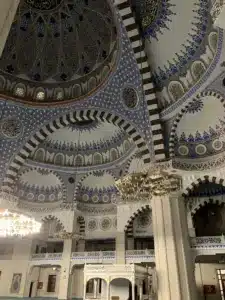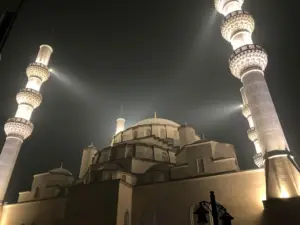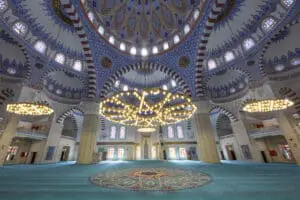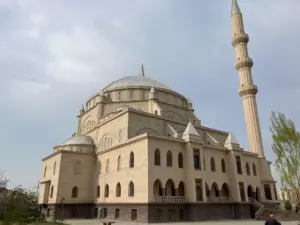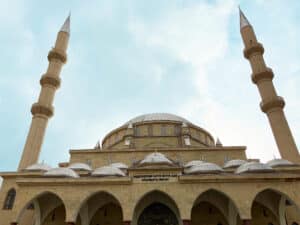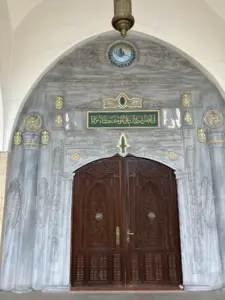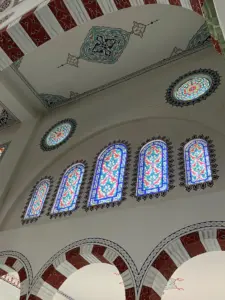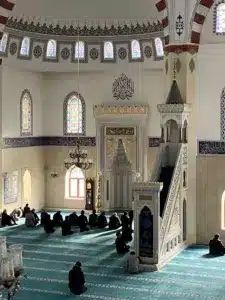The Kyrgyz capital of Bishkek today features mosques scattered throughout its streets. Amazingly, nearly all of these mosques were constructed after the Kyrgyz Republic declared independence in 1991. The city was constructed mostly by Tsarist Russia and the USSR, neither of which encouraged the construction of mosques. The construction boom in Bishkek is testament to how important Islam is to modern Kyrgyz identity – and also is testament to the strong ties that Bishkek has fostered with Turkey, another Turkic-speaking and majority-Muslim nation, which is helped finance and facilitate this construction boom.
Most mosques in Bishkek can be accessed by non-Muslims, so long as you remain quiet and respectful. Women must have their heads covered and must wear clothing that covers the arms to the wrists and the legs to the ankles. No one should wear shorts or sandals to a mosque. If you take pictures, keep them few and discrete and try not to photograph people. Tourists should not visit on a Friday, the Muslim holy day, which is reserved for prayers.
About 85% of Kyrgyz are Muslim. Most are “secular,” meaning that you likely won’t see too many head coverings outside of mosques and rarely will you meet a local who prays five times a day. However, Islam is a major part of Kyrgyz identity. Eid al-Fitr and Eid al-Adha are both state holidays in Kyrgyzstan and some observance of Ramadan can be observed.
The following two sections were written by Lily Nemirovsky, an SRAS student who studied with SRAS in Bishkek in 2023, with research assistance from Josh Wilson, SRAS Assistant Director and General Editor.
Bishkek’s Central Mosques
Bishkek currently has two Central Mosques. seeking out the Central Mosque of Imam Sarakhsi, you’ll need to be a little careful as there is another known as just “Central Mosque” (without the namesake). To perhaps add to the confusion, both Central Mosques are located several blocks apart, with the newer, larger and better known structure near the intersection of Gogol Street and Jibek Jolu Avenue. The older, smaller structure can be seen at the intersection of Gogol Street and Moskovskaya Street.
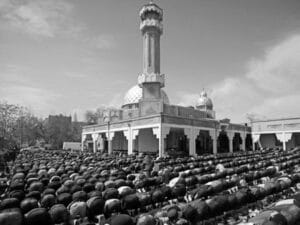
The older structure is well worth a look – if it is still standing. As of May, 2022, it was closed and scheduled for demolition. In its place, a new mosque is to be built with a capacity to serve 10,000 worshipers at once, much larger than the current structure which was built in 1995 and which itself replaced an even smaller structure built in 1944. It is unclear if it will retain the name of Central Mosque, or adopt a new name. In any case, you can check out the “old” Central Mosque with Google Street View.
And so, on a cold Wednesday evening, two of my friends and I decided to visit the revered Imam Sarahsi Bishkek Central Mosque, one of the largest in Central Asia. It was nightfall as we headed out, and we were immediately enveloped by the smell of gasoline, the commotion of Bishkek’s central Chuy Ave and a frosty atmosphere which made us pull our hoods up over our heads. We made our way to the mosque, weaving our way down poorly-lit streets covered in ice towards the northeast corner of the city. The sultry smog was stifling, but when we got our first glimpse of the lit-up minarets piercing the black sky, it was evident that the visit would be worth it. The mosque possessed a grandiosity that demanded awe as we stepped into the parking lot, craning our necks to take in the sand-colored walls, four white 70-meter tall minarets, and a dazzling silver dome.
The Central Mosque of Imam Sarakhsi, also known as the Central Mosque of Bishkek, is one of the largest mosques in Central Asia with an indoor capacity to house 9000 worshippers and a large grounds area for that can increase its capacity to 30,000. Funded by the Turkish government and designed in the Ottoman revival style, the mosque was constructed between 2012 and 2018. It was named after Muhammad bin Ahmad bin Abi Sahl Abu Bakr al-Sarakhsi, an eleventh-century Islamic scholar who studied in nearby Bukhara, Uzbekistan and authored al-Mabsoot, one of the foundational texts of the Hanafi school of thought.
When we neared the entrance, we took our shoes off and stored them in the shelves lining the entryway. It was around 7:30pm, and most of the shelves were empty. When the heavy wooden doors softly closed behind us, the hustle and bustle of the city completely dissipated. A deep turquoise carpet extended across the prayer hall, which was occupied only by a small group of men and boys attending a halaqa and a few separate pairs of worshippers. The multi-domed ceiling covered in elaborate blue and white painted patterns was very much reminiscent of other Turkish mosques I had seen, and I could have spent hours following the detailed flowers, geometric shapes, and Arabic calligraphy that were incorporated into its decoration. Even without being Muslim myself, the placid atmosphere and splendid architecture was moving and wrapped me in a blanket of safety.
Although we saw no signs indicating otherwise, we were not sure that women were allowed on the first floor, so we did not venture far. We left back through the wooden doors before our presence may have become a hindrance. As we put our shoes back on, a middle-aged man stepped out and asked what we had been doing there. I nervously replied that we were just looking, worried that we had broken a rule. But to my surprise, he handed us a few som bills, telling us to get tea for ourselves. A wave of relief washed away my anxiety, and gratitude filled its place. It was one of those moments that seemed straight out of a story, in which the unexpected kindness of a stranger changes the course of a traveler’s day. I felt blessed to have encountered such a moment myself, less than a week into my stay in Kyrgyzstan.
Abdulkarim Satuq Bughra Khan (Dzhal) Mosque
The Abdulkarim Satuq Bughra Khan Mosque lies in the southwest of Bishkek, on the campus of Kyrgyz-Turkish Manas University. This mosque also poses some difficulties in locating it, in part because it is known by two very different names.
If you look for it on Google Maps, you’ll need to look for Dzhal Mosque, named for the city district in which it is located. If you look for it on Yandex Maps, you’ll need to look for Мечеть им. Абдулкерима Сатука Буурахана – in Cyrillic, as Yandex seems to not recognize any Latinized version of the name. Locally, it seems both names are interchangeable – although the university’s website uses the Abdulkarim Satuq Bughra Khan Mosque and makes it clear that this is the official name, as approved by the university and even the Kyrgyz presidency.
The mosque is named after Abdulkarim Satuq Bughra Khan, a 10th century ruler of the Kara-Khanid Khanate who was one of the first Turkic rulers to convert to Islam. His Khanate encompassed all of present-day Kyrgyzstan and much more. His early adoption of Islam was allegedly inspired by Abu an-Nasr, a faqīh from nearby Bukhara, Uzbekistan.
This mosque, extraordinarily spacious and bright, was built as part of the university’s theology department, which stands directly in front of the mosque. It is intended, in part, to serve as a facility for vocational training for theology students, although to that end, it also functions as a normal mosque. It was built mostly with donations from many organizations and philanthropists from Turkey.
Like the Central Mosque in the north of the city, the Abdulkarim Satuq Bughra Khan Mosque is designed in the Ottoman revival style, which was originally developed during the early 19th century to promote Ottoman patriotism against the encroaching influence of Baroque and Neoclassical architecture. It opened in 2015 and can accommodate 4,000 worshipers. If the outdoor grounds are also used, this number can increase to about 8,000.
To reach this mosque, one must first pass through the gates of the Kyrgyz-Turkish Manas University, which appears to be a security checkpoint but which I had no trouble simply walking through.
Beige and silver define the mosque’s outer appearance, with pale almond-colored tiles covering the walls and a metallic sheen emanating off the domes. The building stands over 45 meters tall and has three clearly defined levels. Two 59-meter-tall minarets distinguish the front of the mosque, which is oriented away from the street so that the mihrab faces Mecca.
Both women and men can enter the main entrance to take off their shoes before parting ways to enter the main prayer hall. Men enter straight through the inside doors, while women are supposed to take the staircase to the right, which leads to the second-floor balcony. A plush sky-blue carpet blankets both floors and compliments the white, navy, and maroon geometric floral patterns painted on the inside walls and domed ceiling. Crystal chandeliers hang from the grand central dome, and when I was there, the sun was still high enough to light up the red, blue, and yellow stained-glass windows on the second floor.
As I leaned over the balcony to take in the view and observe the small group of men and boys dressed in black on the floor below, a deep voice gently began broadcasting from a speaker, its rich vibrations saturating the hall. It was the call to prayer, and I decided to slip out before it got too crowded. It was nice to have its reverberations follow me outside, softening some of the contrast between the serenity inside the hall and the ongoing city life on the other side.
Kyrgyzstan’s New Mosques
There is surprisingly little information about Kyrgyzstan’s mosques online. Although there are today more than 3000 of them, the vast majority have histories that go back only decades. The first Kyrgyz mosque to really catch public attention has been the Imam Sarahsi Bishkek Central Mosque – primarily for its sheer size making it, at the time it was built, Central Asia’s largest.
The rapid proliferation of mosques has also likely contributed to confusion within available information, with effective duplication of names for multiple mosques and individual mosques that are listed in sources under differing names. The fact that the Kyrgyz internet is poorly developed also compounds this problem – even Russian-language or even Kyrgyz-language searches yield only slightly better results.
However, Bishkek has many beautiful mosques. These include large new mosques such as the renowned Imam Sarahsi Bishkek Central Mosque, built in 2018 and now a major addition to Bishkek’s skyline. They include quieter mosques like the Al Manara Mosque, located in what is now a Soviet-built sleeping district on the outskirts of the city. They also include smaller mosques like the Osh Bazaar Mosque, tucked quietly away inside the chaos of the city’s main bazaar.
Noticing and appreciating these structures is important for visitors to truly understand Kyrgyz identity and the modern lives now being lived in Kyrgyzstan.
You’ll Also Love
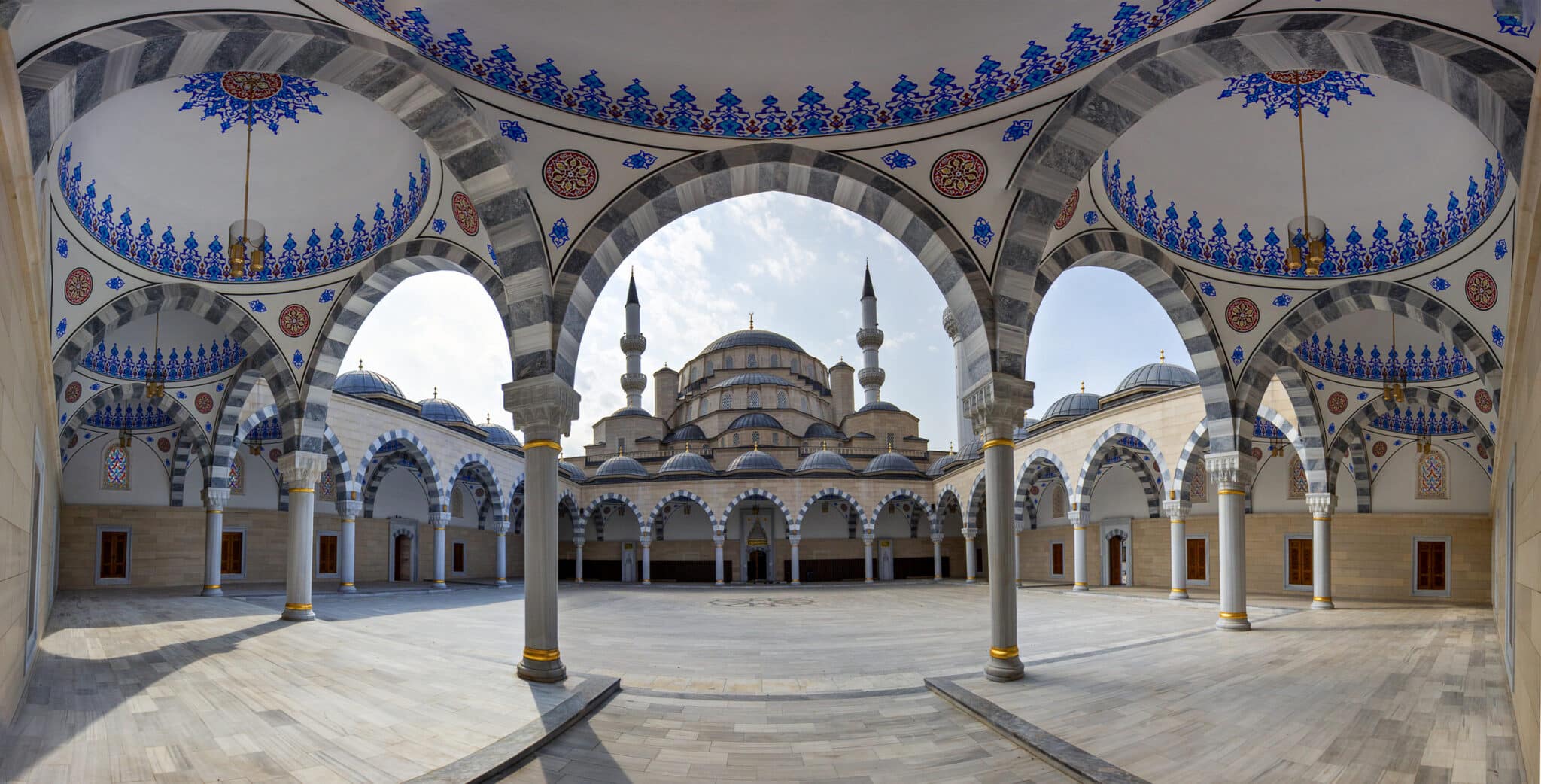
Exploring Bishkek’s Mosques
The Kyrgyz capital of Bishkek today features mosques scattered throughout its streets. Amazingly, nearly all of these mosques were constructed after the Kyrgyz Republic declared independence in 1991. The city was constructed mostly by Tsarist Russia and the USSR, neither of which encouraged the construction of mosques. The construction boom in Bishkek is testament to […]
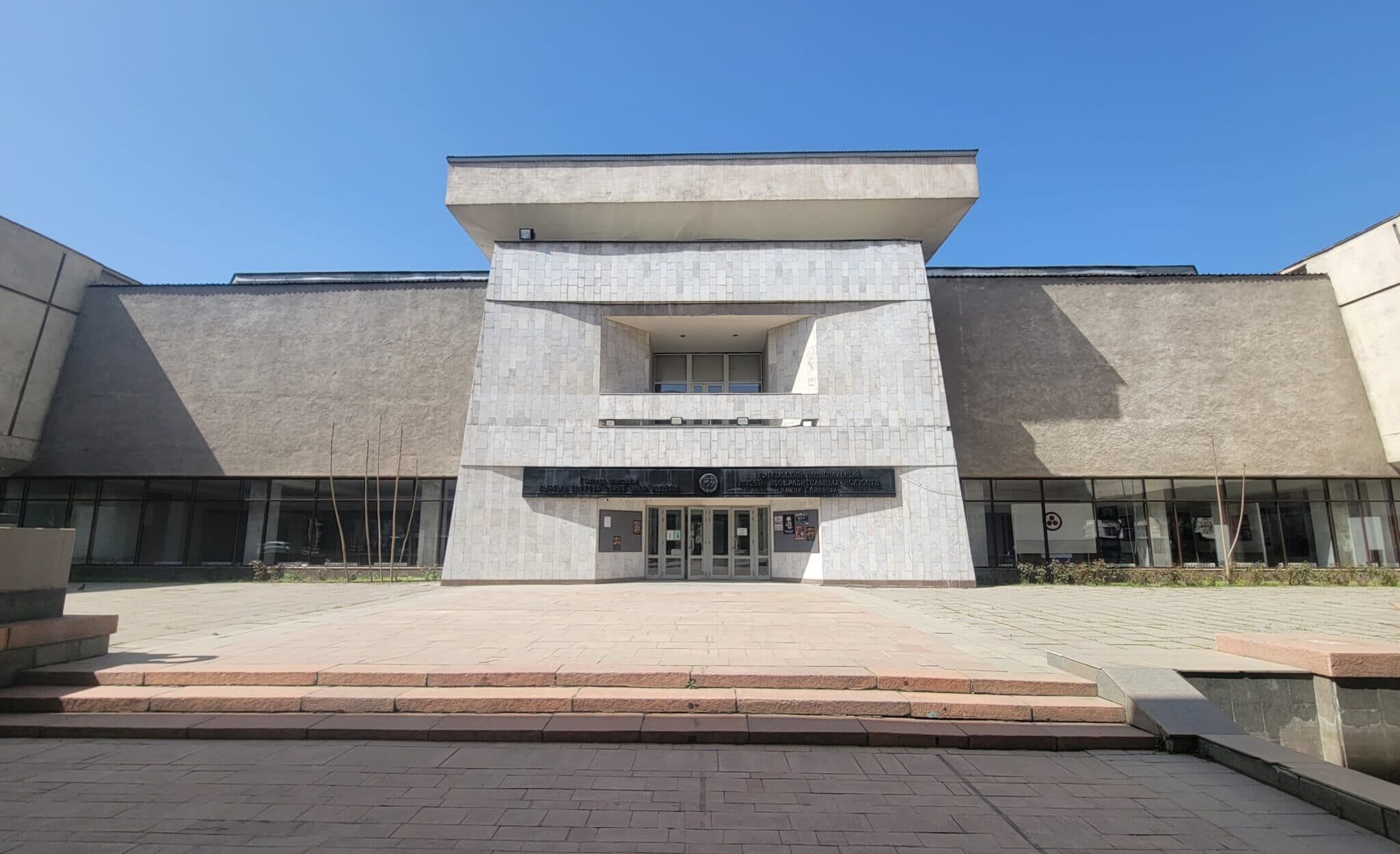
The Kyrgyz National Museum of Fine Arts in Bishkek
The Kyrgyz National Museum of Fine Arts in Bishkek showcases native art forms as well as painting, sculpture, and other works, highlighting those created by Kyrgyz artists. The museum is centrally located and is perfect for a day trip with an abundance of restaurants and cafes nearby. The article below will tell the history of […]
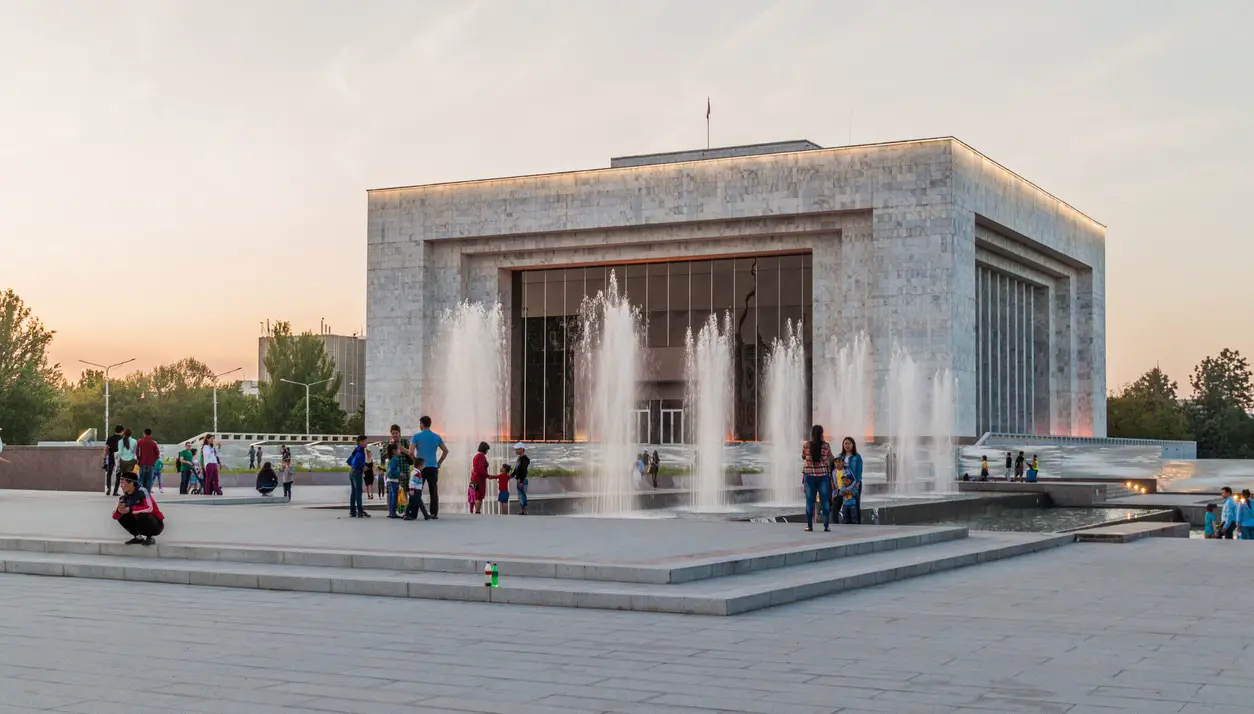
The National Historical Museum of the Kyrgyz Republic
The National Historical Museum of the Kyrgyz Republic is a great place to get started when visiting Kyrgyzstan. The museum’s extensive collection of more than 90,000 exhibits includes artifacts from Kyrgyzstan’s prehistory, from its ancient Silk Road era, Soviet-era history, and modern state. Culture exhibits focus on Kyrgyz nomadic culture, traditional handicrafts, and the musical […]

The Evolution of Art and Painting in Central Asia
While Central Asia has a long, rich history, the modern nations of the region are a direct result of 20th century colonization. Prior to Soviet interference, the many ethnic groups and distinct societies of the region were loosely grouped under the geographic term of Turkestan. Under Soviet control, the region was divided into the Turkmen […]
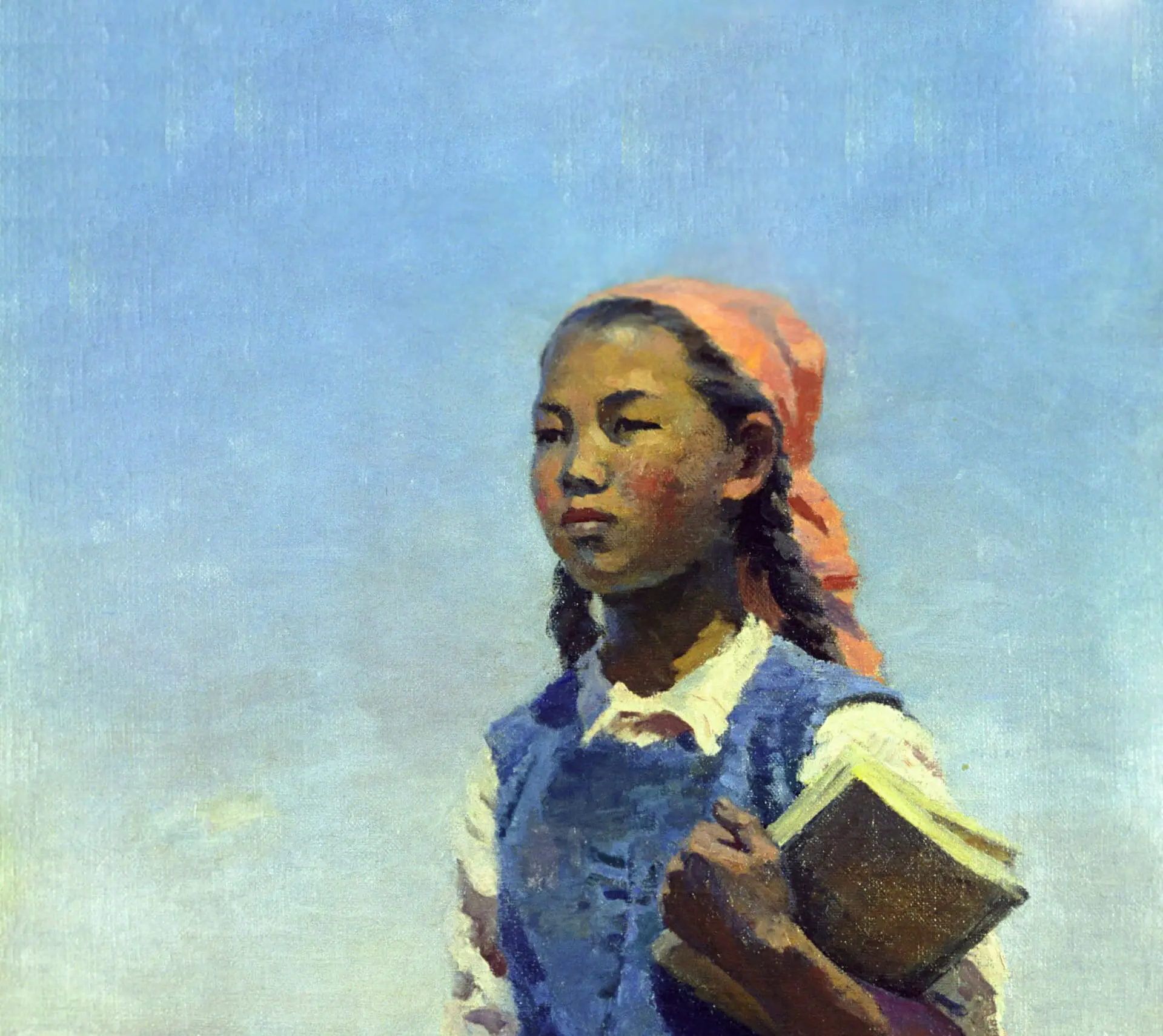
Semyon Chuikov, Founder of Kyrgyz Painting: His Life and House Museum in Bishkek
The Faces of Kyrgyzstan is a project of the popular Russian-language website Limon.kg based in Kyrgyzstan. The project presents those natives of Kyrgyzstan which have helped form the current country and especially its modern culture. The profiles are presented on Limon.kg in Russian. Translation was performed by Sophia Rehm, a SRAS Home and Abroad Scholar […]


